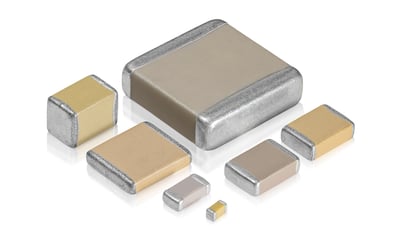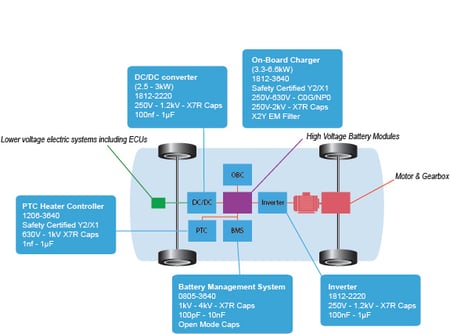The worldwide electric vehicle (EV) market is exploding in demand and mainstream adoption as governments push for fuel economy improvements and automotive companies look for new market opportunities. According to Forbes, “by 2020, EVs are likely to cost the same as conventional fuel powered equivalents.” Major manufacturers – like General Motors, Toyota, and BMW – plan to release “a mouthwatering potential of 400 models and estimated global sales of 25 million by 2025.” For EV design engineers and purchasing agents, this drive towards increased electrification results in the challenge of finding cutting-edge components that can handle increasing temperatures, voltage, and power without sacrificing reliability, availability, and footprint.

Choosing the right MLCC for your automotive application involves researching specifications, certifications, pricing and availability, and many other considerations.
Automotive-grade multilayer ceramic capacitors (MLCCs) are commonly used in EV electronics and subsystems because of their high temperature ratings, tiny size, and easy surface mount form factor. However, in order to qualify for EV applications, they must meet specialized requirements. Important areas of consideration include:
- High Voltage: EV systems are based on high-voltage battery systems, so capacitors must be rated for increased ranges such as 250V to 400V for plug-in hybrid electric vehicles (PHEVs), 800V for commercial vehicles, and 48V for hybrid electric vehicles (HEVs).
- High Power: In order to complete with combustion engine petroleum-based vehicles that are refilled within minutes, companies are focusing on ultra-fast charging solutions, including EV systems that can handle increasing amounts of power (greater than 3.3kW) and charge directly from the grid.
- Reduction in Size: The vehicle’s size and weight will affect its overall energy efficiency, so footprint reduction for EV subsystems (and the components they use) is a priority. Capacitors must therefore provide the same high performance within smaller dimensions.
- High Temperature: By pushing the boundaries with increased voltages, higher converter frequencies, and smaller footprints as mentioned above, all of these factors combine to create a high temperature environment that can be inhospitable to standard parts. Components must be rated to withstand and smoothly perform in those conditions.
- Industrial Reliability: Automotive-grade capacitors are designed to meet stringent standards of robustness, and special features have been developed for the most demanding applications that require increased reliability and superior mechanical performance.

Main subsystems of EVs and PHEVs
To get the full details, read our white paper, "Considerations for Selecting Automotive-Grade Multilayer Ceramic Capacitors in Electric Vehicles", that discusses common MLCC use cases in EV subsystems and capacitor requirements for specific applications.


